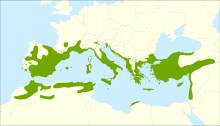圓柄黃連木
外觀
| 圓柄黃連木 | |
|---|---|

| |
| 科學分類 | |
| 界: | 植物界 Plantae |
| 演化支: | 維管束植物 Tracheophyta |
| 演化支: | 被子植物 Angiosperms |
| 演化支: | 真雙子葉植物 Eudicots |
| 演化支: | 薔薇類植物 Rosids |
| 目: | 無患子目 Sapindales |
| 科: | 漆樹科 Anacardiaceae |
| 屬: | 黃連木屬 Pistacia |
| 種: | 圓柄黃連木 P. terebinthus
|
| 二名法 | |
| Pistacia terebinthus | |

| |
| 異名[1][2] | |
| |
圓柄黃連木(學名:Pistacia terebinthus)是漆樹科黃連木屬植物,分布於地中海地區和沙烏地阿拉伯。[2]巴勒斯坦黃連木(學名:Pistacia palaestina)曾經是一個獨立的種,但形態學及分子生物學的研究表明巴勒斯坦黃連木應併入本種。[3][4]
誤稱
[編輯]雖然圓柄黃連木常被稱為篤耨香[5][6][7],但古籍記載中的篤耨香原產柬埔寨一帶,不可能是圓柄黃連木。[8]
圓柄黃連木在台灣常被誤稱為巴西乳香,但二者是不同的植物。巴西乳香是漆樹科肖乳香屬植物,也叫巴西胡椒木。[9]
圓柄黃連木的英文名除了terebinth還有turpentine tree。Turpentine一詞原本指的就是圓柄黃連木和翅軸黃連木的樹脂而不是松節油,後來才演變出松節油的含義。[10][11]某些聖經漢譯本因此將其誤譯為「松樹」。
特徵
[編輯]落葉灌木或小喬木,高2–6(–12)米。奇數或偶數羽狀複葉10–19×6–19厘米。葉柄圓(其它黃連木的葉柄扁平或有稜角),偶見扁平;葉軸無翼。小葉(3–)6–11片,3.5–8×1–3.1厘米, 對生或近對生,卵形至狹卵形,短尖, 逐漸變為革質,微被柔毛或無毛;頂生小葉如果存在的話為1–6×5–20毫米,比側生小葉小。雄花的圓錐花序長8厘米,疏散分枝;苞片大,有白色長毛。雌花的圓錐花序長15(–23)厘米,果期變大;苞片大,初期有白色長毛,但很快脫落。核果發紅,熟時變藍。[2]
用途
[編輯]圓柄黃連木在古代地中海地區被視為具有神奇效力的聖樹。其樹脂品質上乘、香味怡人,用於治病驅邪。不過圓柄黃連木的樹脂產量很低,古代地中海地區的黃連木樹脂可能主要來源於樹脂產量很高的翅軸黃連木。[12][11][13]
參考資料
[編輯]- ^ WCSP (in review). Pistacia terebinthus L.. The Plant List (2013). Version 1.1. 2012-03-23 [2019-06-09]. (原始內容存檔於2020-10-30).
- ^ 2.0 2.1 2.2 Al-Saghir, Mohannad G.; Porter, Duncan M. Taxonomic revision of the genus Pistacia L. (Anacardiaceae). American Journal of Plant Sciences. 2012, 3 (1): 12–32. ISSN 2158-2742. doi:10.4236/ajps.2012.31002.
- ^ Al-Saghir, Mohannad G. Phylogenetic analysis of the genus Pistacia L. (Anacardiaceae) based on morphological data. Asian Journal of Plant Sciences. 2010-01-01, 9 (1): 28–35 [2019-06-12]. doi:10.3923/ajps.2010.28.35. (原始內容存檔於2018-06-10).
- ^ Yi, Tingshuang; Wen, Jun; Golan-Goldhirsh, Avi; Parfitt, Dan E. Phylogenetics and reticulate evolution in Pistacia (Anacardiaceae). American Journal of Botany. 2008-2, 95 (2): 241–251. doi:10.3732/ajb.95.2.241 (英語).
- ^ 清香木(中国植物志). iPlant.cn 植物智——中國植物+物種信息系統. 中國科學院植物研究所系統與進化植物學國家重點實驗室. [2019-12-04]. (原始內容存檔於2021-05-14).
- ^ Pistacia terebinthus L. 篤耨香(本草綱目). 雙語詞彙、學術名詞暨辭書資訊網. 國家教育研究院. [2019-06-09]. (原始內容存檔於2019-06-09).
- ^ 中國農業百科全書總編輯委員會; 果樹卷編輯委員會; 中國農業百科全書編輯部. 果树常见名称拉汉对照. 中国农业百科全书• 果树卷. 北京: 中國農業出版社. 1993 [2021-03-01]. ISBN 9787109025165. (原始內容存檔於2021-05-14).
- ^ 陳敬. 香譜. 中國雅文化經典. 伍茂源(編著). 南京: 江蘇鳳凰文藝出版社. 2019-03-01. ISBN 978-7-5594-3222-3. OCLC 1227078825.
- ^ 國立台灣大學植物標本館. 巴西胡椒木 Schinus terebinthifolius. 台灣植物資訊整合查詢系統. 國立台灣大學生態學與演化生物學研究所. 2012 [2019-06-09].
- ^ Skeat, Walter W. A Concise Etymological Dictionary of the English Language. Oxford, UK: Oxford University Press. 1882: 579.
- ^ 11.0 11.1 Mills, John S.; White, Raymond. Natural resins of art and archaeology: Their sources, chemistry, and identification. Studies in Conservation. 1977, 22 (1): 12–31 [2021-05-14]. ISSN 0039-3630. doi:10.2307/1505670. (原始內容存檔於2021-05-14).
- ^ Beckmann, Sabine. Resin and Ritual Purification: Terebinth in Eastern Mediterranean Bronze Age Cult. Stampolidēs, Nikolaos Chr.; Kanta, Athanasia; Giannikourē, Angelikē (編). Athanasia: The Earthly, the Celestial and the Underworld in the Mediterranean from the Late Bronze and the Early Iron Age. International Archaeological Conference, Rhodes 2009. Hērakleio: Panistēmio Krētēs: 29–42. 2012. ISBN 978-960-7143-40-2.
- ^ Mills, J. S.; White, R. The identity of the resins from the late bronze age shipwreck at Ulu Burun (Kaş). Archaeometry. 1989, 31 (1): 37–44 [2021-05-29]. ISSN 1475-4754. doi:10.1111/j.1475-4754.1989.tb01054.x. (原始內容存檔於2021-06-03).
